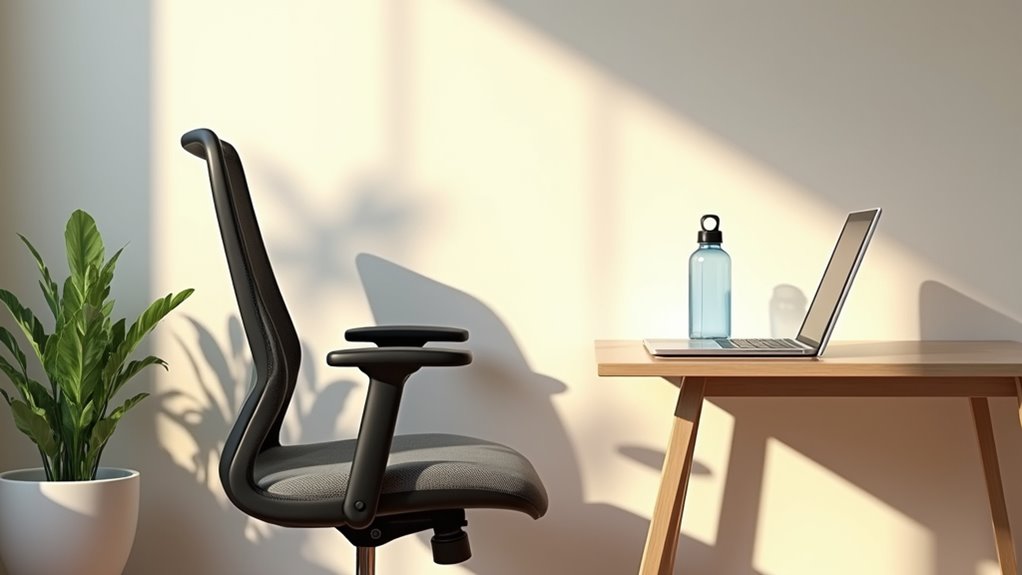How to Sit Properly in a Chair
This post contains affiliate links. As an Amazon Associate, we earn from qualifying purchases.
To sit properly in a chair, adjust the height so your feet rest flat on the ground and your knees form a comfortable 90-degree angle. Maintain a gap of 2-4 fingers between the seat and the back of your knees to avoid any pressure on your thighs. Utilize lumbar support for your lower back, keep your shoulders relaxed, and position your elbows close to your sides. It’s also important to move around every hour to prevent stiffness. For those interested in more detailed tips and explanations, continue reading!
Essential Facts in 30 Seconds
- Adjust seat height for flat feet and 90-degree knees.
- Use lumbar support to align lower back.
- Keep elbows close and forearms parallel to the desk.
- Maintain head level with the screen at eye level.
- Take breaks to stand or stretch every 40-50 minutes.
Seat Height Adjustment
Finding the right seat height is crucial for comfort and focus. Start by measuring from the floor to the back of your knees. Aim for your knees to be at a 90-degree angle. Your feet should rest flat on the ground or on a footrest. This position keeps your legs comfortable and reduces pressure on your lower back. Proper office ergonomics can prevent health issues and enhance your overall well-being. Additionally, make sure to set chair height to avoid slouching, which can lead to discomfort over time. The proper height adjustment can significantly impact your overall comfort while sitting.
Next, check how to adjust your chair. Look for a lever under the seat. Pull it up or down to raise or lower the chair. If there’s a screw mechanism, twist it clockwise to lift the seat. Familiarizing yourself with the lever mechanism will help you make precise adjustments with ease.
After adjusting, sit down and test it out. Make small changes until it feels just right. A good chair helps you stay comfy and focused, so you won’t fidget.
Seat Depth for Thigh Comfort

Getting the right seat depth in a chair is crucial for comfort. Aim for a space of two to four fingers between the seat edge and the back of your knees. This gap prevents pressure on your thighs. Too much pressure can make sitting uncomfortable. A well-fitted chair supports your back and keeps your feet flat on the floor. This position helps you feel stable and ready for any task. Proper seat depth is essential for maintaining overall posture and preventing discomfort during extended periods of sitting. Additionally, ensuring your chair is ergonomically designed can further enhance your sitting experience by providing the necessary support. It’s important to remember that correct sitting posture plays a significant role in overall health and productivity while seated. Maintaining proper alignment not only promotes comfort but also reduces the risk of developing long-term musculoskeletal issues. Comfort matters. It’s not just about sitting; it’s about feeling good while you work or relax. Choose wisely for the best experience.
Ideal Seat Gap
Finding the right seat gap is key for comfort. It helps your legs feel better during long sitting times. Aim for a gap that keeps your knees bent at about 90 degrees. Here’s how to get it right:
- Measure from your hips to 2 inches behind your knees.
- Adjust the seat depth to keep a 2-4 inch gap behind your knees.
- Ensure your feet are flat on the floor.
- Lock in your adjustments to keep everything steady.
With the right seat gap, pressure on your thighs decreases. Ergonomic chairs are specifically designed to support this adjustment, enhancing your overall comfort. Additionally, correct sitting posture can help prevent strain on your back and neck. You’ll feel more energetic. Proper seat depth adjustment is essential for preventing discomfort during extended sitting. Maintaining a proper sitting posture will also provide necessary support for your spine.
Sit back, relax, and give your legs the comfort they need!
Full Back Support
Getting the right seat gap is just the start of a comfy sitting experience. Full back support makes a big difference! To keep your thighs happy and your back supported, check out this guide:
| Seat Depth Range | Recommended User Height |
|---|---|
| 17-18 inches | 5’2″ – 5’6″ |
| 18-20 inches | 5’6″ – 6’0″ |
| 20-22 inches | 6’0″ and taller |
| Adjustable | All heights |
Choose the right seat material and chair design for extra comfort. Aim for a seat depth that leaves a 2-4 inch gap behind your knees. This helps avoid discomfort and keeps your blood flowing. Additionally, proper sitting reduces risk of back pain and enhances your overall comfort while seated. Consider adding a lumbar support cushion to maintain the natural curve of your spine. Proper height adjustment can also aid blood circulation and prevent thigh pressure. Enjoy your time sitting!
Lumbar Support and Back Positioning
Lumbar support is essential for your back while sitting. It helps maintain the natural curve in your lower back. A supportive chair can enhance overall well-being during long hours of work. Proper chair height adjustment is crucial for achieving the ideal knee angle while seated.
A well-aligned chair backrest gives your spine a cozy hug. This support reduces tiredness and keeps discomfort away. You can focus better on your tasks. Think of it as a ninja move against aches!
Proper lumbar support can boost your comfort and productivity. Invest in a good chair to protect your back. A small change can make a big difference. A lumbar roll or cushion can be a great addition if your chair lacks proper support.
Stay comfy and ready for anything!
Importance of Lumbar Support
After a long day, settling into your favorite chair should feel great.
But is your back getting the support it needs? Lumbar support is essential for a happy spine.
Here are some benefits of using a lumbar cushion:
- It keeps your spine in a natural S-shape.
- It reduces strain on your lower back.
- It spreads pressure evenly, lowering fatigue.
- It helps you maintain good posture while sitting.
- Proper lumbar support configuration can further enhance comfort during extended use.
Chairs with adjustable lumbar support are the best choice.
A comfy back means better focus and fewer aches. Proper sitting position is crucial to maximizing the benefits of lumbar support.
Let’s take care of your back and make your sitting experience enjoyable!
Optimal Backrest Positioning
Sitting in a chair with the right backrest makes a big difference. A well-positioned backrest keeps you comfortable and supported. Adjust the height to support your whole back. It should touch your shoulders and lower back. This improves your posture and reduces strain. Proper backrest support also helps in enhancing seat comfort, which can further alleviate discomfort during long hours of sitting. Additionally, a well-designed backrest is essential for maintaining spine alignment, contributing to overall well-being. A chair with lumbar support is especially beneficial for long-term health.
Check these important backrest features:
| Backrest Feature | Importance |
|---|---|
| Height | Supports the whole back for comfort |
| Tilt Angle | Lessens pressure on lower back discs |
| Tension Adjustment | Provides balanced support for easy movement |
Tilt your pelvis slightly forward while sitting. This helps keep your spine neutral. Make these ergonomic changes, and your back will feel great!
Limb Alignment and Arm Position

To sit comfortably and avoid aches, get your limb alignment and arm position right. Follow these tips for better posture:
- Keep your elbows close to your body. This helps prevent shoulder strain.
- Position your forearms parallel to your desk. This provides good support and reduces wrist pain.
- Adjust your armrests so they fit just under your elbows. This allows your shoulders to relax.
- Keep your upper arms near your torso. This stops awkward reaching or leaning.
Proper elbow positioning and forearm support reduce muscle fatigue. A good setup keeps your posture in check.
Remember to adjust if you find yourself leaning forward. Your body will feel better, and you’ll be ready to work more effectively.
Head, Neck, and Shoulder Alignment

Getting your arms and limbs sorted is just the start. Next, focus on your head, neck, and shoulders. Proper head positioning keeps your head right above your shoulders. This reduces strain and helps avoid forward head posture. Keep your gaze straight ahead. Position your screen at eye level for better alignment.
Here’s a quick guide for you:
| Alignment Aspect | Tips | Benefits |
|---|---|---|
| Head Positioning | Keep it neutral and level | Reduces muscle fatigue |
| Neck Curvature | Maintain a natural curve | Prevents stiffness and pain |
| Shoulder Tension | Relax and pull back slightly | Supports head and neck alignment |
Practice chin tucks and stretch your chest often. This helps you stay aware of your posture. Small changes make a big difference. Great job focusing on your posture!
Movement and Sitting Duration Guidelines

Sitting for long periods can feel nice, but it can also lead to health problems. To keep your body healthy, follow these tips:
- Sit for less than 7 hours each day.
- Stand or move for at least 2 hours daily.
- Take a 5-minute break for every 40 to 50 minutes of sitting.
- Stretch your legs and feet often to help blood flow.
These simple actions can keep you feeling good and active throughout the day.
Make movement a part of your routine to stay healthy!
Frequently Asked Questions
What Type of Chair Is Best for Prolonged Sitting?
For long hours of sitting, ergonomic chairs are the best choice. They provide lumbar support, helping you maintain good posture. This support reduces strain on your back and increases comfort. Adjustable features are essential. They let you change the height, armrest, and seat depth. A good fit keeps you comfortable while you work.
Look for chairs with breathable materials. This helps keep you cool and prevents sweating. Cushioned seats add extra comfort too. Consider chairs with wheels for easy movement. This way, you can reach for items without straining.
How Often Should I Adjust My Sitting Position?
Your body needs to move. Adjust your sitting position every 20 to 30 minutes. It helps keep you aligned and energized. Set reminders to shift your posture. Regular changes can prevent discomfort. Staying active boosts your productivity. Remember, movement is key to feeling good while sitting.
Can Sitting Posture Affect My Mood?
Your sitting posture affects your mood more than you might think. Sitting up straight can make you feel happier. It helps to push away negative thoughts. On the other hand, slouching can increase feelings of anxiety and sadness. So, pay attention to how you sit! Keep your back straight and shoulders back. This small change can boost your mood and make a big difference in your day. Remember, good posture is key to feeling good!
What Are Signs of Poor Sitting Posture?
Slouching shows clear signs. Look for rounded shoulders and a forward head tilt. You might feel discomfort, like neck tension or back pain. Frequent adjustments in your seat can also indicate poor posture. These signs suggest that your posture needs attention. Correcting it can prevent further issues and improve your well-being. Good posture helps you feel better and stay healthy.
How Can I Improve My Sitting Habits?
Your body often sinks into a chair without thinking about comfort. Improve your sitting habits with a few simple changes. Start by adjusting your chair. An ergonomic chair supports your back and encourages good posture. Sit with your feet flat on the floor. Your knees should be at a right angle.
Engage your core muscles. This helps support your spine and keeps you balanced. Remember to check your screen height too. Your eyes should be level with the top of your screen. This reduces neck strain.
Take breaks every hour. Stand up, stretch, or walk around. These small movements keep your blood flowing and reduce stiffness. Drinking water also helps. It reminds you to get up and move.
Mindful sitting is important. Pay attention to how you feel. Adjust your posture if you start to slouch. With these tips, you can sit comfortably and improve your health.
Conclusion
Sitting properly in a chair is very important. Good posture keeps your back comfortable and helps you stay focused. Adjust your seat to fit your height. Make sure your feet touch the floor. Support your lower back with a cushion or lumbar support. Keep your arms relaxed at your sides. Your knees should be at a 90-degree angle.
Don’t forget to take breaks. Stand up and stretch every hour. This keeps your body active and reduces stiffness. Remember, good posture is like a superhero’s tool. It helps you feel strong and ready to tackle anything. You’ve got this!
